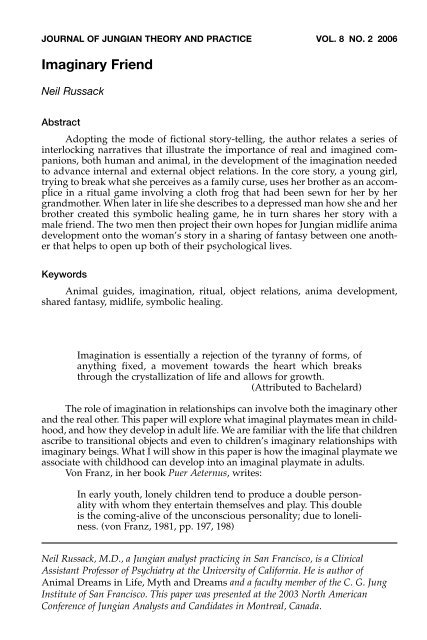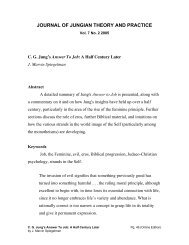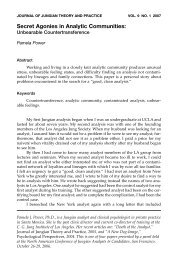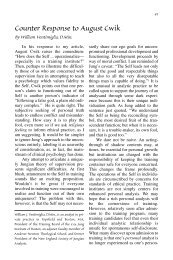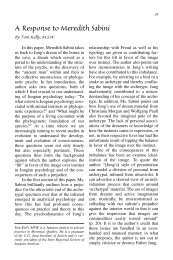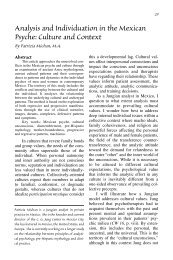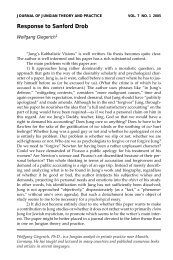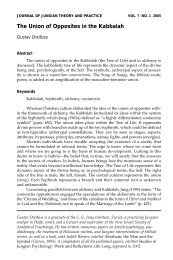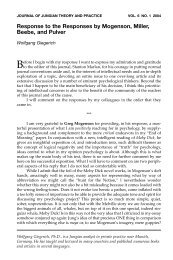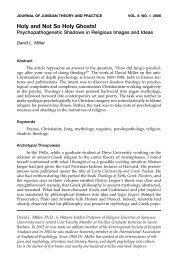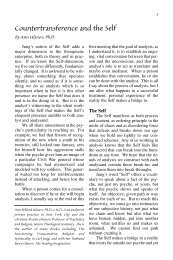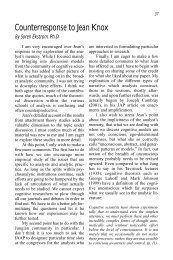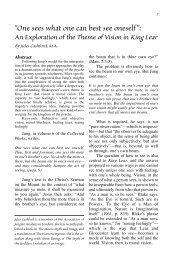Imaginary Friend - CG Jung Institute of New York
Imaginary Friend - CG Jung Institute of New York
Imaginary Friend - CG Jung Institute of New York
You also want an ePaper? Increase the reach of your titles
YUMPU automatically turns print PDFs into web optimized ePapers that Google loves.
JOURNAL OF JUNGIAN THEORY AND PRACTICE VOL. 8 NO. 2 2006<br />
<strong>Imaginary</strong> <strong>Friend</strong><br />
Neil Russack<br />
Abstract<br />
Adopting the mode <strong>of</strong> fictional story-telling, the author relates a series <strong>of</strong><br />
interlocking narratives that illustrate the importance <strong>of</strong> real and imagined companions,<br />
both human and animal, in the development <strong>of</strong> the imagination needed<br />
to advance internal and external object relations. In the core story, a young girl,<br />
trying to break what she perceives as a family curse, uses her brother as an accomplice<br />
in a ritual game involving a cloth frog that had been sewn for her by her<br />
grandmother. When later in life she describes to a depressed man how she and her<br />
brother created this symbolic healing game, he in turn shares her story with a<br />
male friend. The two men then project their own hopes for <strong>Jung</strong>ian midlife anima<br />
development onto the woman’s story in a sharing <strong>of</strong> fantasy between one another<br />
that helps to open up both <strong>of</strong> their psychological lives.<br />
Keywords<br />
Animal guides, imagination, ritual, object relations, anima development,<br />
shared fantasy, midlife, symbolic healing.<br />
Imagination is essentially a rejection <strong>of</strong> the tyranny <strong>of</strong> forms, <strong>of</strong><br />
anything fixed, a movement towards the heart which breaks<br />
through the crystallization <strong>of</strong> life and allows for growth.<br />
(Attributed to Bachelard)<br />
The role <strong>of</strong> imagination in relationships can involve both the imaginary other<br />
and the real other. This paper will explore what imaginal playmates mean in childhood,<br />
and how they develop in adult life. We are familiar with the life that children<br />
ascribe to transitional objects and even to children’s imaginary relationships with<br />
imaginary beings. What I will show in this paper is how the imaginal playmate we<br />
associate with childhood can develop into an imaginal playmate in adults.<br />
Von Franz, in her book Puer Aeternus, writes:<br />
In early youth, lonely children tend to produce a double personality<br />
with whom they entertain themselves and play. This double<br />
is the coming-alive <strong>of</strong> the unconscious personality; due to loneliness.<br />
(von Franz, 1981, pp. 197, 198)<br />
Neil Russack, M.D., a <strong>Jung</strong>ian analyst practicing in San Francisco, is a Clinical<br />
Assistant Pr<strong>of</strong>essor <strong>of</strong> Psychiatry at the University <strong>of</strong> California. He is author <strong>of</strong><br />
Animal Dreams in Life, Myth and Dreams and a faculty member <strong>of</strong> the C. G. <strong>Jung</strong><br />
<strong>Institute</strong> <strong>of</strong> San Francisco. This paper was presented at the 2003 North American<br />
Conference <strong>of</strong> <strong>Jung</strong>ian Analysts and Candidates in Montreal, Canada.
2 <strong>Imaginary</strong> <strong>Friend</strong><br />
She goes on to discuss the archetypal expression <strong>of</strong> this other as it has manifested<br />
in primitive societies, in which the human, when born, is split into two,<br />
one half entering this world and the other remaining in the spirit world: upon<br />
death, they reunite. Psychologically, this mirrors the split between the conscious<br />
and unconscious aspects <strong>of</strong> the personality (p. 199).<br />
In the events used as illustration in this paper, a man developed an imaginal,<br />
but real, relationship with a woman. Because they did not become lovers, they<br />
were able to enter into an imaginal realm, just as children might when they play<br />
imaginary games together. For the man, the relationship came to embody an<br />
aspect <strong>of</strong> his undeveloped imagination, healing him <strong>of</strong> an early wound <strong>of</strong> isolation<br />
and loneliness.<br />
Because there is a high emotional tension in projected relationships, it is difficult<br />
to hold a balance between allowing an exploration to occur, with the risk <strong>of</strong><br />
literal enactment, and cutting it <strong>of</strong>f altogether, thus losing its potential healing<br />
value. What I will show is how an adult can enter a pr<strong>of</strong>ound union, a union that<br />
gives him an ecstatic connection to his own inner world. Between enactment and<br />
repression, there is a middle way. How we meet the other in this way, in or out <strong>of</strong><br />
analysis, can be crucial.<br />
I discovered this, vicariously, through my connection to a man named Nigel.<br />
He was my neighbor, and he and I took walks together after our dogs introduced<br />
us. Nigel’s dog, Maggie, was a pretty but finicky Blue Heeler, an Australian cattle<br />
dog, and my dog, Moss, was an older, patient Border Collie, a sheep dog. The two<br />
dogs became familiars who opened a twilight world in which the two <strong>of</strong> us could<br />
talk openly and intimately.<br />
Nigel was a pr<strong>of</strong>essor, originally English, and had been close to a sister who<br />
was his psychic companion in childhood and who died just before he came to the<br />
U.S. to college. Even though he spoke lovingly <strong>of</strong> his wife and their eight-year-old<br />
daughter, he seemed lonely.<br />
After Moss died we kept up our custom <strong>of</strong> walking and, as if the opening<br />
made in me by grief called forth an opening in him, he told me how he had<br />
become captivated by a beautiful, younger Polish woman, Sophie. When they<br />
met, she felt a sympathy with him and began immediately to tell him the story <strong>of</strong><br />
her close childhood relationship to her brother. From that first moment <strong>of</strong> storytelling,<br />
he stood spellbound, like the wedding guest in Coleridge’s The Rime <strong>of</strong> the<br />
Ancient Mariner.<br />
Sophie’s story began with her grandmother Ada. An uneducated woman,<br />
she was the daughter <strong>of</strong> a glove maker, a tyrant who gave no money to his wife.<br />
From age twelve, Ada would stay late in the factory making gloves so as to have<br />
money to give her mother. She married young and was happy with her husband,<br />
but life was hard through two world wars. She loved her grandchildren and got<br />
the idea to please them by transforming gloves into frogs. Being about the same<br />
size, the captive fingers <strong>of</strong> the glove filled with rice became the frog’s wiggly<br />
limbs. The grandmother sewed the frogs at night and placed them on the sleeping<br />
children’s pillows. The old woman, brought up in a strict, dutiful household,<br />
wove all her repressed feeling into these animals, and as a result they seemed<br />
magical. The grandchildren, delighted to discover these frogs in the morning,<br />
incorporated them into remarkable imaginative play; they ritually killed and res-
Neil Russack 3<br />
urrected them. They remind me <strong>of</strong> the magic toys that come to life at night in<br />
E.T.A. H<strong>of</strong>fman’s Nutcracker Story or Hans Christian Anderson’s The Steadfast Tin<br />
Soldier.<br />
I could see how Nigel was captivated by Sophie’s story and, to my surprise,<br />
I found myself captivated too and making notes drawing on my own long habit<br />
<strong>of</strong> keeping clinical records. Nigel himself, trained as a scholar, kept a journal <strong>of</strong> the<br />
things she said. Much later, after the connection had more or less run its course,<br />
he shared his notes with me. By then my imagination had entered so fully into this<br />
vicarious relationship that, when I read Nigel’s notes, it was as though I could<br />
hear Sophie speaking directly.<br />
Sophie was six or seven when she and her brother began playing with legos.<br />
They made structures like airplanes and got the idea that these cloth frogs could<br />
drive the planes. “She, the frog, has to drive these things,” Sophie explained.<br />
“Being mischievous, behind my grandmother’s back we used to throw these<br />
newly made lego structures against the walls. We would build them to throw<br />
them. We could be quite destructive, as children sometimes are. I don’t know how<br />
we decided to kill our frogs; I think it just happened. We built funerary vessels for<br />
the frogs out <strong>of</strong> legos <strong>of</strong> specially chosen primary colors, blues and greens. Each<br />
<strong>of</strong> us had our own unique vessel.”<br />
Sophie’s grandmother transmuted gloves to frogs, the children transmuted<br />
frogs into something else. It was like an assembly line for the imagination. From<br />
these homespun animals, a frog ritual evolves. Her brother is in tune with the<br />
magical world and she, inspired by him, follows his lead. “Without him,” Sophie<br />
tells Nigel, “I don’t know that I would have developed.”<br />
She went on: “My brother would make my frog’s funerary vessel and I his. We<br />
felt that the frog was meant to have this happen. It was her fate. To the accompaniment<br />
<strong>of</strong> the rock group ‘The Doors,’ we would stand at the top <strong>of</strong> the cellar stairs<br />
and one at a time hurl these funerary assemblages down the cellar steps to crash<br />
below. Seeing the flight <strong>of</strong> the c<strong>of</strong>fin over the staircase, knowing they were going to<br />
their deaths, was terribly exciting. We would gather up our killed frogs and then,<br />
and only then, did they truly belong to us. They had to die before they could be<br />
ours. By killing them, we freed them up to become themselves. My brother and I<br />
worshipped our frogs and carried them around with us wherever we went.”<br />
Sophie recounted that “each frog went through one major funeral. It was an<br />
initiatory experience. Then she got to drive anything after that. She was a royal<br />
frog. My brother’s frog was white and red and I was very jealous <strong>of</strong> his frog. It was<br />
very organic, very voluptuous, very fat. My frog was more tailored, more civilized.<br />
It had more shape to it. It was red and black, the color <strong>of</strong> the underworld,<br />
and reminds me now <strong>of</strong> that Greek story <strong>of</strong> Persephone eating the pomegranate.<br />
My brother’s frog was more original, more primitive. What his frog looked like<br />
was not important to him. The frog didn’t need to be an expression <strong>of</strong> him. He was<br />
not as identified with it as I was.”<br />
She continued: “The killing <strong>of</strong> the frogs freed their spirit, which meant that<br />
we, too, were freed from the family curse which was a lack <strong>of</strong> warmth. We needed<br />
to use our imagination and express our feelings. We had a deep commitment<br />
to one another and we would talk to one another through our animals. My animal<br />
would talk to his animal. This led, later on, to my doing puppetry for children.”
4 <strong>Imaginary</strong> <strong>Friend</strong><br />
Sophie explained that the funerary games were played in secret. She said:<br />
“We were afraid our grandmother would find out. When she did catch us; she<br />
would exclaim, ‘What are you doing? You are destroying frogs and furniture,’ and<br />
we would laugh and then she would laugh. Then we would pick them up with<br />
great excitement, put them with their back on our palm face up as if they were<br />
dead. We would carry them out <strong>of</strong> there, as if they had seen something on their<br />
journey down the stairs.<br />
“My brother and I were very tight. We would throw our frogs at the same<br />
time. We would look into each other’s eyes, like lovers, like we were going to die.<br />
It was like stepping into a third place between two people; it was a chemical reaction.<br />
It is always easier to die with someone else, to discover something known on<br />
the other side, that eternal thing. We looked for it in childhood. It was a most liberating<br />
event for children. It bonded my brother and I, knowing the trust <strong>of</strong> the<br />
dark elements <strong>of</strong> God.<br />
“Finding out about the ritual didn’t stop my grandmother from making animals<br />
for us. She made them for us throughout her life; the last one six months<br />
before she died. She always knew what they meant for us. She would stop everything<br />
when we would run to her crying, ‘She’s wounded, she’s bleeding,’ when<br />
the skin <strong>of</strong> the frog would break and rice would spill out, falling over us. There<br />
was a sense <strong>of</strong> urgency. We would become particularly excited when this happened.<br />
The frog might be dying. We knew on one level it was a game, but it<br />
seemed terribly real. We knew grandmother could repair it, we were helped by<br />
knowing she could heal. She would soothe us with her warm smile, yet she<br />
enjoyed the power as the only one we could turn to. She could give life back to the<br />
frogs. My mother on the other hand wouldn’t respond. When Teddy, (my teddy<br />
bear), lost an ear and I would run to my mother crying, ‘Teddy can’t hear,’ my<br />
mother wouldn’t care. She wouldn’t fix it and I was devastated.<br />
“What we were really saying when we brought injured frogs to grandmother<br />
was ‘Can you fix us, can you heal us?’ Even now I see these frogs still there, still<br />
standing, not losing sustenance. It makes me feel like everything is o.k.<br />
“Each time the frog underwent a death and rebirth, it became more special.<br />
It had survived. A frog hierarchy developed; the older ones had been through hell<br />
and back whereas the newer frogs were not as important because they didn’t<br />
know anything.<br />
“When Grandma said she had new thread that wouldn’t show, we didn’t<br />
want that. Each frog had a cosmic scar. If we kept her from that, she wouldn’t<br />
come into her own. The frogs had to remain vulnerable, they had to be responsible<br />
for their actions. Every time we threw a frog down, we felt the fire. We were<br />
compelled to do this. It was the inevitable fate <strong>of</strong> the frog. We realized that she was<br />
on an immense journey. Now I think it had to do with coming to terms with the<br />
greater design <strong>of</strong> things.<br />
“There was a feeling <strong>of</strong> urgency. Children have a feeling for that. The frog<br />
needed to die. Everything built up to that moment. It was a pr<strong>of</strong>ound moment<br />
which I couldn’t have done alone. I needed a partner on the journey to the underworld.<br />
“I was a child who kept to herself and my brother opened me up. He would<br />
come into my room with fantastic ideas and new ways <strong>of</strong> seeing the world. He
Neil Russack 5<br />
would suggest games and show me his new inventions. He would bring in Pink<br />
Floyd records.”<br />
Sophie and her brother remained close their whole life, but she married and<br />
went on to develop a career. He, on the other hand, became more and more withdrawn,<br />
and eventually killed himself.<br />
Listening to Nigel retell Sophie’s story in the dark <strong>of</strong> the night, I could hear<br />
the trembling <strong>of</strong> Nigel’s voice and its reverberations in his limbs when he would<br />
stop or wave his arm. Often it was as though he were talking to himself or to some<br />
imaginary figure up ahead, rather than to me. I could feel a fever in Nigel’s thinking<br />
about Sophie, as if there were now two people inside him, he and she, spellbound<br />
by her enchanted frog. Evoking the c<strong>of</strong>fin in the story, he covets what he<br />
lost. In carefully writing down Sophie’s words, it was as if Nigel were recovering<br />
the imaginary play with his own sister; Sophie’s words became a secret code to fill<br />
the void. Hearing about the children’s violent and ecstatic emotions, as the frog<br />
transformed, affected me also and grew into an unexpected feeling <strong>of</strong> well-being.<br />
I thought <strong>of</strong> exotic things, <strong>of</strong> travels in India, when I witnessed the fervor with<br />
which relatives ran chanting under torchlight through the narrow streets <strong>of</strong><br />
Varanasi, carrying the bodies <strong>of</strong> their loved ones to the burning ghats.<br />
Walking many nights in the dark with Nigel, I was drawn into his and<br />
Sophie’s story, not just by the intense eros that bound them to each other, but by<br />
the power <strong>of</strong> the imagination itself. I began to see that Sophie represented something<br />
to me too. Observing the intensity <strong>of</strong> his desire for Sophie, and the sorrow<br />
that was its natural accompaniment, I began to understand a great many things<br />
about my own early life. I noticed the heaviness and seriousness that hung in the<br />
air about me. I saw that I too had learned how to do things not out <strong>of</strong> joy but duty.<br />
In adult life, my spirit had been kindled by connections with animals, and<br />
these connections underlay my fascination with Sophie’s frog story. I knew from<br />
my studies that the frog is a symbol <strong>of</strong> rebirth. Its moist skin, retained from its loss<br />
<strong>of</strong> fish elements, was a way <strong>of</strong> staying close to the memory <strong>of</strong> the primary self and<br />
it lived around water its whole life. And I recalled the Frog Prince fairy-tale, <strong>of</strong> a<br />
little princess, who, by throwing a frog against the wall, transforms her instincts<br />
into human feeling. Why didn’t this knowledge satisfy me? Something still mysterious<br />
held me. I wanted to be with Sophie and her brother, throwing my frog<br />
down with theirs.<br />
Hearing the story <strong>of</strong> Sophie through Nigel, I began to wonder how I could<br />
retroactively enter the world <strong>of</strong> the imagination and receive the nourishment it<br />
<strong>of</strong>fered. C. G. <strong>Jung</strong> could play with stones in midlife to heal himself, and this<br />
worked because he had played with them as a child. I couldn’t just suddenly play<br />
with little frogs; there had to be another way <strong>of</strong> making up for the absence <strong>of</strong><br />
childhood connection to the world <strong>of</strong> imagination. So vicariously, through Nigel,<br />
I, too, connected with Sophie, who even at this remove became a guide for me, a<br />
way to find my way back, as an adult in an adult way.<br />
The reader may wonder how I could so easily enter into Nigel’s and Sophie’s<br />
world. The easy answer is that it’s my job to be affected by people, to let their<br />
worlds touch me so that I can accompany them. And there was something else here<br />
as well. You have to remember, it was night, and even though we walked with our
6 <strong>Imaginary</strong> <strong>Friend</strong><br />
dogs in our neighborhood, it felt as if we were on another planet. An intimacy<br />
developed between us, different from that between a doctor and his patient. I could<br />
feel myself entering his psyche and was reminded <strong>of</strong> Joseph Conrad’s story The<br />
Secret Sharer, in which a ship captain alone on watch in the dead <strong>of</strong> night in the<br />
South Seas picks up a half-dead man out <strong>of</strong> the water. The captain feels a strange<br />
empathy for the man. Conrad (1942) writes, “A mysterious communication was<br />
already established between us two—in the face <strong>of</strong> that silent, darkened tropical<br />
sea” (p. 273), and after hearing the swimmer’s story <strong>of</strong> murdering a shipmate on<br />
another ship and then escaping, the captain decides to hide him in his own cabin.<br />
As they begin to live secretly together in the small room, the captain realizes:<br />
He was not a bit like me, really; yet, as we stood leaning over my<br />
bed-place, whispering side by side, with our dark heads together<br />
and our backs to the door, anybody bold enough to open it<br />
stealthily would have been treated the uncanny sight <strong>of</strong> a double<br />
captain busy talking in whispers with his other self. (Conrad,<br />
1942, p. 276)<br />
The story ends when the secret sharer leaves the ship to swim for a nearby island,<br />
“a free man, a proud swimmer striking out for a new destiny” (p. 292).<br />
Walking with Nigel, I got an inkling <strong>of</strong> what it might feel like to strike out on<br />
my own, to live from my imagination, to have a life uniquely my own.<br />
The frog is on its journey too. She lets things happen to her. She surrenders<br />
to the ultimate change, death, and in the process, she is altered. Because she comes<br />
back from the dead she becomes a catalyst for transformation and thereby helps<br />
us to build a new internal structure. She becomes a psychic architect that opens us<br />
to the imaginal and teaches us to assimilate our imaginative experiences by making<br />
them our own. Sophie and her brother lost something <strong>of</strong> their individual<br />
selves by merging, and gained it back when both children wound up with their<br />
own frogs. Sophie told Nigel that the weight <strong>of</strong> the frog, which she would put on<br />
her chest at night to comfort her, made these changes real.<br />
The frog helped Sophie and Nigel and, eventually, vicariously, me, to objectify<br />
and stay rooted in the imaginary realm, as irrational as it was and as irrationally<br />
as it came about. It seemed strange to rely on an imaginary frog jumping<br />
about inside me. How could I fall under the enchantment <strong>of</strong> a woman’s frog?<br />
The British psychoanalyst Christopher Bollas, in his book The Shadow <strong>of</strong> the<br />
Object, Psychoanalysis <strong>of</strong> the Unthought Known, would conceive <strong>of</strong> Sophie’s frog as<br />
being a transformational object that refers to the child’s mother, the first transformational<br />
object. He finds that adults, in an attempt to reexperience this transformative<br />
process, search for an object with intense longing and a wish to fuse, “the<br />
object being identified with such powerful metamorphoses <strong>of</strong> being, . . .[with] the<br />
uncanny quality, the sense <strong>of</strong> being reminded <strong>of</strong> something never cognitively<br />
apprehended but existentially known” (Bollas, 1987, p. 17). Bollas speaks <strong>of</strong> Moby<br />
Dick, saying that “Ahab feels compelled to seek the whale, even though he feels<br />
alienated from the source <strong>of</strong> his own internal compulsion. . . . There is something<br />
impersonal and ruthless about the search for the whale, and indeed for all objects<br />
nominated as transformational; . . . The experience is neither social nor moral, . . .
Neil Russack 7<br />
as the object is sought out only as deliverer <strong>of</strong> an experience” (pp. 27, 29). This<br />
describes Nigel’s increasing desire for Sophie and my increasing fascination for<br />
their story.<br />
Edward Edinger (1995) refers to the white whale as a symbol <strong>of</strong> transformation<br />
that Ahab fails to understand. For a <strong>Jung</strong>ian, the unknowable thing that we<br />
are always in search <strong>of</strong> in our life is found in symbols and objects. What interests<br />
me in the comparison is that the search for the transformational object is just as<br />
powerful for both schools.<br />
As Nigel and Sophie began spending more time together, he grew alarmed<br />
and felt his life was out <strong>of</strong> control. She gave herself emotionally to him, in a way<br />
he thought not possible, not even as he remembered being with his sister. He<br />
began living in two worlds, one, the normal outer world <strong>of</strong> teaching and family,<br />
and this inner world <strong>of</strong> traveling with Sophie. He was at a turning point similar<br />
to one in the Conrad story, when the captain begins to talk to his first mate in<br />
whispers as if he is talking to his secret sharer and realizes that he can no longer<br />
keep his double secret.<br />
In listening to Nigel’s tale, I could see that part <strong>of</strong> Sophie was identified with<br />
Aphrodite, constellating the erotic wherever she went. He told me: “Sophie suggested<br />
a walk to a nearby beach. She was wearing an azure blue kerchief to match<br />
her aquamarine eyes, and an orange top. She looked like a young girl going on a<br />
picnic with her boyfriend. Excited to be near the water, she drew a magic circle<br />
around us in the sand. Then she told a dream in which blocks <strong>of</strong> color descended<br />
on her as a way <strong>of</strong> enticing her to come down to earth and remembered a magic<br />
circle her brother had placed them in to comfort her when she was frightened as<br />
a child.”<br />
At dusk, on the way back, Nigel said, the howls <strong>of</strong> coyotes encircled them,<br />
echoing <strong>of</strong>f the surrounding hills, giving them a sense that they were still in an<br />
imaginary space. “What are coyotes symbols <strong>of</strong>?” Nigel asked me. At midlife, I<br />
told him, he was entering that liminal zone, characterized by that trickster-creator<br />
god Coyote.<br />
The imaginal realm was coming to life the way it does for children who<br />
believe in the reality <strong>of</strong> the imagination. As a ten-year-old boy in a formidable<br />
household, <strong>Jung</strong> carved a manikin to relieve his loneliness and put him in a pencil<br />
box to stay in so it wouldn’t be lonely either. The creation <strong>of</strong> this figure became<br />
part <strong>of</strong> a secret life that he remembered only later in life. For the child, imagination<br />
is real. Grown-ups call it the imagination, but for children it is reality.<br />
On the beach, when a strange child comes upon a group <strong>of</strong> children, the new<br />
child will stand for awhile watching the other children, and then suddenly, without<br />
any formal introduction, she simply enters the game by adding something to<br />
the sandcastle and the other children, without missing a beat, accept the child. It<br />
is a sacred space and all who enter it automatically have a place. Nigel was that<br />
stranger child outside the magic circle and Sophie gave him a way to get in. And<br />
I, listening to his tale, found a way in too.<br />
I began to see that the imagination wasn’t just imagination to inform us<br />
about our life, but a dimension unto itself, a reality on its own.
8 <strong>Imaginary</strong> <strong>Friend</strong><br />
In the film Matter <strong>of</strong> Heart, M. L. von Franz speaks <strong>of</strong> meeting <strong>Jung</strong>:<br />
I met him when I was eighteen. . . . He told that story which you<br />
can read in the Memories about this girl who was on the moon and<br />
had to fight a demon, and the black demon got her. And he pretended,<br />
or he told it in a way as if she really had been on the moon<br />
and it happened. And I was rationalistically trained from school<br />
so I said indignantly, “But she imagined to be on the moon, or she<br />
dreamt it, but she wasn’t on the moon.” And he looked at me<br />
earnestly and said, “Yes, she was on the moon.” I still remember<br />
looking over the lake and thinking, “Either this man is crazy, or I<br />
am too stupid to understand what he means.” And then it suddenly<br />
dawned on me, “He means that what happens psychically<br />
is the real reality, and this other moon, this stony desert which<br />
goes around the earth, that’s illusion, or that’s only pseudo-reality.”<br />
And that hit me tremendously deeply. When I crawled, rather<br />
drunk into bed because he gave us a lot <strong>of</strong> Burgundy that<br />
evening, I thought, “It will take you ten years to digest what you<br />
experienced today.” (Whitney, 1985, p. 3)<br />
To <strong>Jung</strong>, the imagination and its expression in children through the creation<br />
<strong>of</strong> imaginary friends was the healthy expression <strong>of</strong> the inner reality <strong>of</strong> the child.<br />
Studies have since indicated that imaginary friends are not always compensation<br />
for loneliness, but can be healthy companions to a child’s growing imaginative<br />
life. Marjorie Taylor, a developmental psychologist, states in her book <strong>Imaginary</strong><br />
Companions and the Children Who Create Them that<br />
an imaginary playmate isn’t any kind <strong>of</strong> trauma-marker. It’s just<br />
the opposite: it’s a sign that the child is now confident enough to<br />
begin to understand how to organize her experience into stories.<br />
The significant thing about imaginary friends is that the kids know<br />
they’re fictional. . . . [They are] just pretend. (Gopnick, 2002, p. 81)<br />
Children with imaginary friends or personified objects <strong>of</strong>ten include them<br />
with the family at the dinner table. One day Sophie sat her frog in front <strong>of</strong> a third<br />
plate at lunch with Nigel. By living so openly in this imaginal space herself, and<br />
by instantly connecting with people on that psychic level, she evoked a longing in<br />
anyone who has lost their connection to their sacred inner world.<br />
While Sophie’s imaginary playmate was a frog, the term is also useful for<br />
describing what Sophie herself meant to Nigel. I could have used Bollas’s “transformational<br />
object” or even <strong>Jung</strong>’s “anima.” 1 Yet, because much <strong>of</strong> Sophie’s and<br />
Nigel’s time together was spent in imaginary play, I think imaginary playmate<br />
best describes what went on.<br />
Marjorie Taylor (1999) says, “Most adults enjoy some sort <strong>of</strong> fantasy consumption,<br />
whether movies or novels, but the more interesting comparison with<br />
childhood imaginary companions centers on adult production <strong>of</strong> fantasy material”<br />
(p. 146). And she goes on to give a myriad <strong>of</strong> examples, from Jimmy Stewart’s<br />
portrayal <strong>of</strong> Elmer Dowd’s befriending a white rabbit to C. S. Lewis’s Narnia nov-
Neil Russack 9<br />
els. I wonder if one definition <strong>of</strong> love might be our making an adult companion<br />
into an imaginary playmate or being able to move in and out <strong>of</strong> these dimensions.<br />
When Chagall paints himself and his wife, Bella, flying over ro<strong>of</strong>tops, we enter<br />
with them into the mystical world <strong>of</strong> psychic union which might underlie every<br />
healthy relationship.<br />
The tension in Nigel’s and Sophie’s relationship reached a fever pitch when<br />
Nigel came to think that Sophie was sleeping with an acquaintance <strong>of</strong> his. Driven<br />
crazy with desire, he asked Sophie to sleep with him. She told him tactfully that<br />
she wasn’t attracted to him, that physical intimacy was not what the relationship<br />
meant for her.<br />
Gradually, Nigel realized that not having an actual fusion with Sophie was<br />
fortunate for him. He had to rearrange his mind, to discover a connection with her<br />
that was both imaginative and very real. In Winnicott’s terms, Nigel was able to<br />
sustain the destruction <strong>of</strong> the subjective object <strong>of</strong> his desire (Winnicott, 1991). He<br />
moved “from relation to me-objects with which we merge . . . to objects that assert<br />
themselves as not-me” (Ulanov, 2001, p. 102). Surviving such a loss opens up the<br />
imagination and creative living from the true self. Winnicott observes the numinous<br />
in the child transforming in time, and <strong>Jung</strong> is explaining the numinous in the<br />
eternal infinite.<br />
By being simultaneously available and not, Sophie forced Nigel to internalize<br />
what she carried for him and therefore to find his healing. Acting out such a relationship<br />
doesn’t seem to further the imagination. An example <strong>of</strong> this can be seen in<br />
the relationship between Christiana Morgan and Harry Murray. In the love relationship<br />
between Rilke and Lou Andreas-Salomé, she realized that Rilke was so<br />
contained in the relationship with her that he stopped writing. So, much to his dismay,<br />
she ended it, although she may have had her own self-interested reasons too.<br />
As Nigel’s and Sophie’s relationship began winding down, I too would find<br />
myself listening in a half-interested way. I stopped taking notes. In the heat <strong>of</strong><br />
Nigel’s passion for Sophie, he wanted to merge with her or drop her altogether<br />
because the relationship seemed to threaten the very foundations <strong>of</strong> his life.<br />
Whenever he confided in me that he felt he should end it, he became even more<br />
caught up with her when next he saw her. But gradually he began to accept the relationship<br />
as part <strong>of</strong> his life. He saw that he could remain married with his child and<br />
still take walks with Sophie as if she were his sister. He was reconnecting to the part<br />
<strong>of</strong> himself that had fallen <strong>of</strong>f when his sister died. Through Sophie, his world was<br />
united again. That mystical union, that innocence, had mended the fabric <strong>of</strong> time.<br />
His sadness had lifted, and even his dog Maggie seemed more relaxed and was<br />
friendlier to me. I could almost pet her without her withdrawing or curling her lip.<br />
Looking back, Nigel couldn’t quite understand why Sophie had stirred up<br />
so much emotional turmoil for him, why he had felt at times as if his life were<br />
being torn apart. He acknowledged that if she changed her mind about sleeping<br />
with him, he still would, but that he didn’t need to, and that he was actually<br />
relieved to have his life back. He would see her now every so <strong>of</strong>ten and sometimes<br />
she would call him on the telephone. As for Nigel and me, we still walk together,<br />
only not so frequently. Knowing that I still miss my dog, Nigel volunteered that I<br />
was welcome to walk Maggie on my own.
10 <strong>Imaginary</strong> <strong>Friend</strong><br />
I never did walk Maggie, but rather I began walking my own dog, now long<br />
dead. I talked to him as I used to when he was alive. Walking my imaginary animal<br />
each night, I was beginning to find my own way, as was Nigel in telling<br />
Sophie’s story, waving his arms half-mad with desire. The dog, up ahead, was<br />
leading me into the future which I couldn’t see in the dark <strong>of</strong> the night, where I<br />
didn’t have to see. I knew there were things I wanted to write about, but I could<br />
wait, the way I wait for other events, the way I am waiting to see what death, in<br />
its time, will bring. I didn’t have to worry about my life ahead <strong>of</strong> time. And my<br />
life wasn’t heavy or serious; rather, I would find myself laughing, spontaneously,<br />
about nothing at all.<br />
As Coleridge (1985, p. 236) said, “Through Imagination, Man discovers the<br />
world as it was meant to be.”<br />
Notes<br />
1). I understand that Lacan speaks <strong>of</strong> the “imaginary” as a developmental stage in infancy.<br />
I am not using the term in that sense but, rather, in the way that Charles Stewart points to<br />
a child’s “imaginary companion” as a stage in the development <strong>of</strong> the symbolic life <strong>of</strong> the<br />
child that accompanies, and is an impetus to, ego development (Stewart, 2001) .<br />
References<br />
Bollas, Christopher. (1987) The shadow <strong>of</strong> the object. <strong>New</strong> <strong>York</strong>: Columbia University Press.<br />
1987.<br />
Conrad, Joseph. (1942). The secret sharer. Garden City: Doubleday, Doran & Company, Inc.<br />
Coleridge, Samuel Taylor. (1985). The collected works <strong>of</strong> Samuel Taylor Coleridge (Vol. 7):<br />
Biographia Literaria. Princeton: Princeton University Press.<br />
Edinger, Edward F. (1995). Melville’s Moby-Dick: An American nekyia. Toronto: Inner City<br />
Books.<br />
Gopnick, Adam. (2002, September 30). Bumping into Mr. Ravioli. The <strong>New</strong> <strong>York</strong>er.<br />
Stewart, Charles. (2001). The symbolic impetus: How creative fantasy motivates development.<br />
London: Free Association.<br />
Taylor, Marjorie. (1999). <strong>Imaginary</strong> companions and the children who create them. Oxford:<br />
Oxford University Press.<br />
Ulanov, A. B. (2001). Finding space. Louisville, KY: Westminster John Knox Press.<br />
Von Franz, M. L. (1970). Puer aeternus (2nd ed.). Boston: Sigo Press.<br />
Whitney, Mark. (1985). Matter <strong>of</strong> heart [Screenplay]. Los Angeles: C. G. <strong>Jung</strong> <strong>Institute</strong> <strong>of</strong> Los<br />
Angeles.<br />
Winnicott, Donald (1991). Playing and reality. <strong>New</strong> <strong>York</strong>: Routledge.


